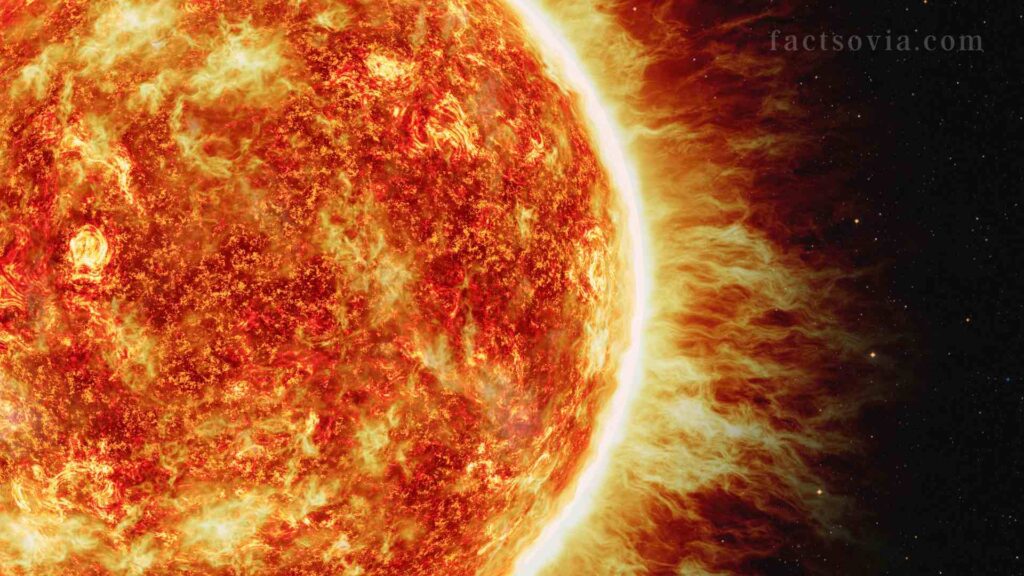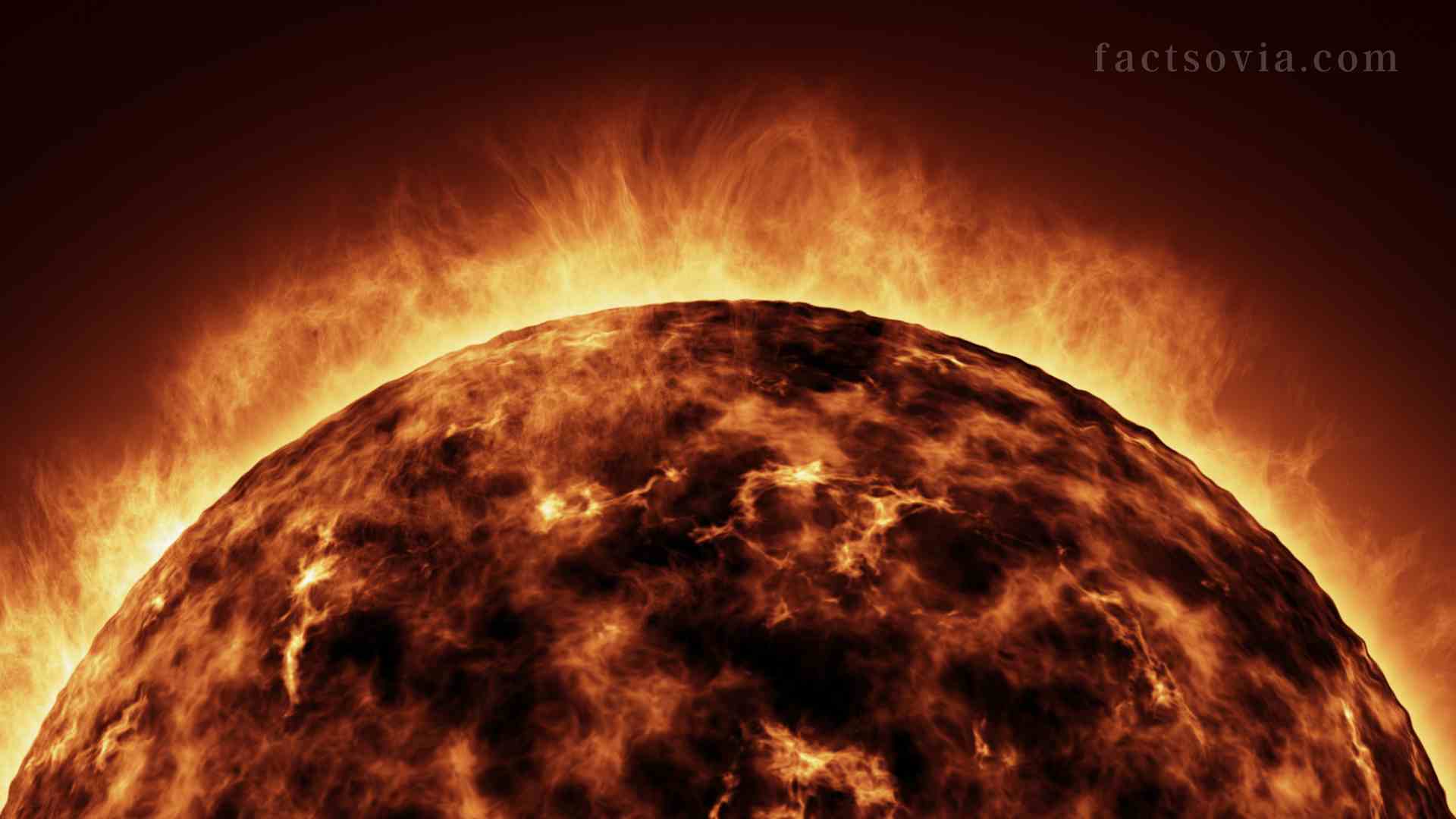We use affiliate links to run our site. When you buy through links on our site, we may earn an affiliate commission, without any added cost to you. Learn more
The sun is by far the largest object in our solar system. This scorching ball of gases dwarfs even the massive Jupiter. But have you ever stopped to think about the sun’s sheer surface area? Our home star boasts an unfathomable amount of surface—over 11,000 times the area of Earth!
In this post, we’ll explore the factors that contribute to the sun’s vast surface and imagine what it would be like on Earth if we had even a fraction of that surface area to utilize. Then we’ll answer some frequently asked questions about the mind-boggling extent of the sun’s surface.
Does The Sun Have A Surface?
The sun is comprised of swirling hot plasma rather than solid matter. But astronomers still refer to the sun as having a “surface” region called the photosphere. This is the layer from which light radiates out into space.
The sun rotates faster at its equator than at the poles. But for the purposes of calculating total surface area, astronomers assume the sun is a perfect sphere. Based on the sun’s measured equatorial diameter of about 864,580 miles, we can compute its total surface area.
Taking into account the sun’s radius of 432,290 miles, the total surface area of the photosphere is over 23 trillion square miles! For comparison, the surface area of Earth is just 197 million square miles. So the sun has over 11,900 times more surface area than our planet.
The surface area is a critical factor in studying stars. It influences various phenomena, including energy emissions, solar weather, and interactions with other celestial bodies.
What If We Could Live on The Sun:
Now let’s imagine for a moment that we could build livable structures on the sun’s surface. If we were to spread the Earth’s population of 7 billion evenly across the sun’s expanse, every man, woman, and child would have over 3 square miles to themselves!
Of course, the intense gravity, searing heat, and solar radiation would instantly incinerate any hypothetical sun-dwellers. But it puts the sheer vastness of the sun’s surface area into perspective. All the land area on Earth would take up just a tiny speck of the sun’s enormous photosphere.
If the sun’s surface could be divvied up into countries for each person, we could give every individual over 1,600 acres of sun real estate! Clearly, lack of lebensraum or living space will never be an issue on our home star.
10 Surprising and Little-Known Facts About the Sun
How to Calculate the Sun’s Surface Area
Astronomers can determine the sun’s diameter and radius by measuring the tiny dips in sunlight that occur when Venus transits across the sun’s disc from our viewpoint. Based on these precise measurements, combined with the known formula for the surface area of a sphere:
Area = 4πr2
They can compute the sun’s total surface area down to a square mile. The values are so enormous that it takes some imaginative thinking to really comprehend the sheer size!
Some Key Facts on the Sun’s Surface:
– Equatorial Circumference: About 2.7 million miles
– Latitude Circumference: 2.1 million miles at 45° N/S latitude
– Amount of Sunlight that Reaches Earth: Just 1 billionth of the total emitted
– Sun’s Mass: 330,000 times greater than Earth
The Surface Area Of Planets In Our Solar System:
| Name | Total Surface Area (in 10^6 Km^2) | Ratio To Earth Value | Sun’s Surface Area (Ratio to Other Planet) |
| Pluto | 17.7 | 0.035 | 343432.08 |
| Moon | 38 | 0.074 | 159967.05 |
| Mercury | 74.8 | 0.15 | 81266.68 |
| Mars | 144.4 | 0.28 | 42096.59 |
| Venus | 460.2 | 0.9 | 13208.93 |
| Earth | 510.1 | 1 | 11916.78 |
| Neptune | 7618 | 14.93 | 797.95 |
| Uranus | 8083 | 15.85 | 752.04 |
| Saturn | 42700 | 83.71 | 142.36 |
| Jupiter | 61420 | 120.41 | 98.97 |
| Sun | 6078747.77 | 11916.78 |
How Far is The Moon From The Sun
The Sun Compared to Other Stars
Here is a table of 10 known stars and their sizes compared to the Sun:
| Star Name | Diameter (relative to the Sun) |
| Sirius A | 1.71 |
| Pollux | 8.8 |
| Arcturus | 25.1 |
| Aldebaran | 44.2 |
| Rigel | 78.9 |
| Pistol Star | 154 |
| Antares A | 883 |
| Mu Cephei | 1,650 |
| VY Canis Majoris | 1,800-2,100 |
| Stephenson 2-18 | 2,160 |
What Happens on The Surface of The Sun

The surface of the Sun is home to incredible activity and dynamic processes. This is driven by the intense heat and pressure generated by nuclear fusion reactions at the Sun’s core. Some of the most notable phenomena that occur on the solar surface include:
- Solar flares – Sudden bursts of energy and radiation caused by releases of magnetic energy in the Sun’s atmosphere. Flares can be as powerful as billions of atomic bombs.
- Sunspots – Temporary dark spots on the surface marked by intense magnetic activity. Sunspots are cooler than surrounding regions and come in cycles over days to weeks.
- Coronal mass ejections – Enormous eruptions of solar material and magnetic fields from the corona into space. CMEs can travel at high speeds toward Earth.
- Solar prominences – Large, glowing gaseous loops that rise up from the surface along magnetic field lines. Prominences can last for months.
- Granulation – The grainy texture of the surface caused by rising and sinking convection cells known as granules. This transfers heat from the interior.
- Solar wind – The constant stream of charged particles emitted by the Sun that flows through the solar system.
- Chromosphere and corona – Layers of the Sun’s atmosphere above the visible surface, seen during eclipses as a reddish layer and glowing halo.
Why The Surrounding Area of The Sun is Hotter Than The Surface
The solar corona, the outer atmosphere of the Sun, is hotter than the surface of the Sun. This counterintuitive phenomenon occurs for a few key reasons:
The complex magnetic fields around the Sun interact and reconnect, releasing tremendous amounts of energy that heat the corona.
Waves like Alfvén waves and vibrations also deposit energy into the corona as they pass through the outer layers. Small bursts called nanoflares may occur continuously, releasing heat. Turbulence and magnetic waves drive energy transfer into the corona.
While the exact mechanisms are still being researched, it is clear the dynamic, magnetized environment of the Sun’s atmosphere enables the corona to reach temperatures over a million degrees – far hotter than the surface below.
Frequently Asked Questions (FAQs):
How is the surface area of the sun calculated?
The surface area of the sun is calculated by using its radius and applying the formula for the surface area of a sphere.
What is the surface area of the sun in miles
The surface area of the Sun is approximately 2.35 x 10^6 square miles
What is the surface area of the sun in km
The surface area of the Sun is approximately 6.09 x 10^6 square kilometers
What is the surface area of the sun in meters
The surface area of the Sun is approximately 6.09 x 10^12 square meters
What is the surface area of the sun in feet
The surface area of the Sun is approximately 6.56 x 10^13 square feet
What is the surface area of the sun in inches
The surface area of the Sun is approximately 3.93 x 10^9 square inches
What is the surface area of the sun compared to the earth
The Sun’s surface area is approximately 12,000 times greater than Earth’s total surface area. To put it in perspective, the Sun’s surface area is approximately 6.09 x 10^12 square meters, while Earth’s surface area is around 510.1 million square kilometers (5.101 x 10^14 square meters).
Does the surface area of the sun change over time?
Yes, the surface area of the sun can vary slightly due to solar activity and changes in its outer layers.
Amazon and the Amazon logo are trademarks of Amazon.com, Inc, or its affiliates.
